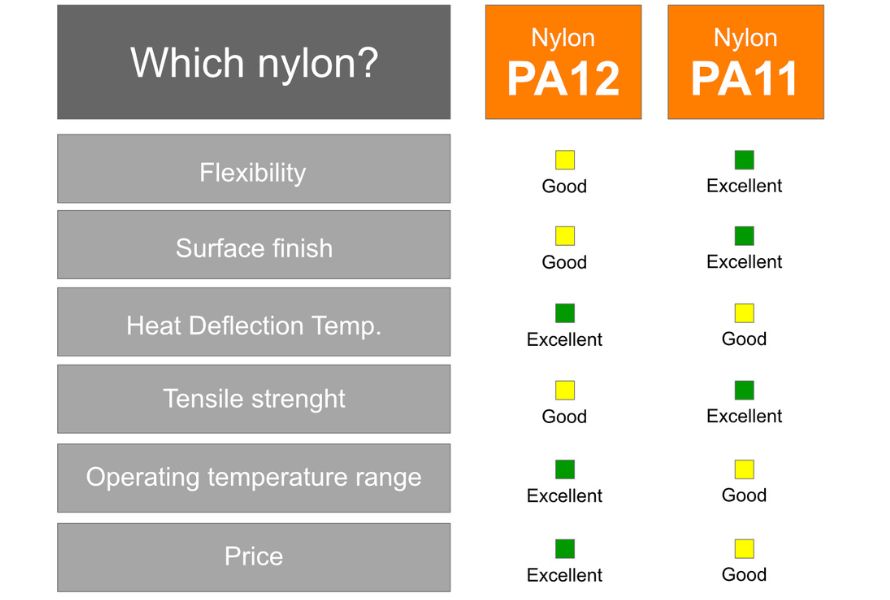Ievads
Neilons ir viens no universālākajiem un visplašāk izmantotajiem sintētiskajiem polimēriem, un no tā dažādajiem veidiem neilons 11 un neilons 12 izceļas ar savām unikālajām īpašībām. Neilons 11 pret neilonu 12 - abi materiāli pieder alifātisko poliamīdu grupai un atkarībā no to paredzētā lietojuma sniedz atšķirīgas priekšrocības. Izpratne par neilona 11 un neilona 12 atšķirībām ir būtiska, lai izvēlētos pareizo materiālu konkrētiem lietojumiem. Šajā rakstā mēs aplūkosim abu materiālu ķīmiskās īpašības, priekšrocības, trūkumus un reālos lietojumus, sniedzot jums visaptverošu rokasgrāmatu, kas palīdzēs pieņemt pamatotu lēmumu.

Neilona 11 īpašības
Neilons 11, pazīstams arī kā poliamīds 11, ir bioloģiskas izcelsmes polimērs, kas iegūts galvenokārt no rīcineļļas. Tas ir pazīstams ar augstu triecienizturību, elastību un lielisku ķīmisko izturību, kas to padara piemērotu dažādiem sarežģītiem lietojumiem. Šeit sniegts tā galveno īpašību sadalījums:
Ķīmiskā struktūra un īpašības
Neilonam 11 ir garas ķēdes molekulārā struktūra ar 11 oglekļa atomiem atkārtojuma vienībā. Šāda struktūra nodrošina uzlabotu elastību, izturību un noturību pret mitruma absorbciju. Tas ir mazāk pakļauts hidrolīzei salīdzinājumā ar citiem neiloniem, tāpēc ir piemērots mitrai videi.Pielietojums dažādās nozarēs
Neilonu 11 bieži izmanto automobiļu, aviācijas un kosmosa rūpniecībā un elektrotehnikas nozarē, kur detaļas ir pakļautas skarbiem apstākļiem. To izmanto degvielas padeves līnijām, hidrauliskajām šļūtenēm, elektrības savienotājiem un pārklājumiem, pateicoties tā izcilajai ķīmiskajai un termiskajai stabilitātei.Priekšrocības un trūkumi
Priekšrocības:- Augsta ķīmiskā izturība, īpaši pret eļļām un degvielām.
- Lieliska veiktspēja un elastība zemās temperatūrās.
- Bioloģiski tīra un videi draudzīgāka, jo tās izcelsme ir rīcineļļa.
Trūkumi:
- Salīdzinoši dārgs, salīdzinot ar citiem zeķbiksīšiem.
- Dažos lietojumos var būt grūtāk apstrādāt.
Neilona 12 īpašības
Neilons 12jeb poliamīds 12 ir vēl viens alifātiskais poliamīds, kas ir pazīstams ar savu izcilo veiktspēju dažādos lietojumos. Atšķirībā no neilona 11, kura pamatā ir bioloģiskas izejvielas, neilonu 12 parasti iegūst no naftas izejvielām. Izpētīsim tā īpašības:
Ķīmiskā struktūra un īpašības
Neilonam 12 ir īsāka molekulārā ķēde nekā neilonam 11, ar 12 oglekļa atomiem atkārtojuma vienībā. Tas nodrošina lielāku elastību un mazāku mitruma absorbciju. Neilonam 12 ir arī labāka izmēru stabilitāte un lielāka nodilumizturība.Pielietojums dažādās nozarēs
Tāpat kā neilonu 11, neilonu 12 izmanto automobiļu, rūpniecības un medicīnas nozarēs. To parasti izmanto tādos izstrādājumos kā caurules, degvielas padeves līnijas un elastīgas plēves, kā arī medicīnas ierīcēs, piemēram, katetros un zāļu piegādes sistēmās.Priekšrocības un trūkumi
Priekšrocības:- Mazāka mitruma absorbcija nekā daudzi citi neiloni, kas nodrošina labāku izmēru stabilitāti.
- Labāka nodilumizturība un gludāka virsmas apdare.
- Rentablāks salīdzinājumā ar neilonu 11.
Trūkumi:
- Mazāka izturība pret eļļām un degvielām salīdzinājumā ar neilonu 11.
- Mazāk bioloģiskās bāzes, tāpēc tas ir mazāk videi draudzīgs nekā neilons 11.
Neilona 11 un neilona 12 salīdzinājums
Izvēloties starp neilonu 11 un neilonu 12, jāņem vērā vairāki faktori. Salīdzināsim abus materiālus pēc dažādiem parametriem, lai labāk izprastu to veiktspēju.
Mehāniskās īpašības
Neilonam 11 ir augstāka triecienizturība un kopumā tas ir elastīgāks, tāpēc tas ir ideāli piemērots lietojumiem, kur ļoti svarīga izturība un elastība. Tomēr neilonam 12 ir labāka nodilumizturība, tāpēc tas ir piemērots lietojumiem, kur nepieciešama gluda virsma un zema berze.Ķīmiskā izturība
Neilons 11 izceļas ar ķīmisko izturību, īpaši vidē, kas pakļauta eļļām, degvielām un smagām ķīmiskām vielām. Neilons 12, lai gan joprojām ir izturīgs, šajos apstākļos nav tik labs.Siltuma īpašības
Gan neilonam 11, gan neilonam 12 ir laba termiskā stabilitāte, taču neilonam 11 ir augstāks kušanas punkts, tāpēc tas ir piemērotāks izmantošanai augstās temperatūrās. No otras puses, neilonam 12 ir labāka elastība zemās temperatūrās.Izmaksu salīdzinājums
Neilons 12 parasti ir pieejamāks nekā neilons 11, jo tā ražošana notiek no naftas. Lai gan neilona 11 bioloģiskā bāze ir labvēlīga videi, tā cena ir augstāka.
Neilons 11 pret neilonu 12, Kurš ir labāks?
Lēmums par neilona 11 vai neilona 12 izmantošanu ir atkarīgs no vairākiem faktoriem, tostarp no konkrētā pielietojuma prasībām. Šeit ir daži galvenie apsvērumi:
Faktori, kas jāņem vērā
- Vides apstākļi: Augsttemperatūras un degvielu izturīgiem lietojumiem neilons 11 var būt labāka izvēle. Tomēr, ja svarīgāka ir zema mitruma absorbcija un izmēru stabilitāte, piemērotāks varētu būt neilons 12.
- Izmaksu efektivitāte: Neilons 12 parasti ir lētāks, un tas varētu būt piemērots lietojumiem ar zemākām mehāniskām prasībām.
- Ietekme uz vidi: Neilons 11 ir videi draudzīgāks, jo tā izcelsme ir bioloģiska, savukārt neilona 12 ražošana, izmantojot naftas produktus, padara to mazāk ilgtspējīgu.
Sekmīgu lietojumu gadījumu izpēte ar katru materiālu
- Neilons 11 in Automobiļu nozare: Degvielas padeves līnijām un hidrauliskajām šļūtenēm automobiļu rūpniecībā ir neilona 11 izturība pret eļļām un ekstrēmām temperatūrām, kas nodrošina ilgstošu veiktspēju.
- Neilons 12 in Medicīna: Medicīnas jomā neilonu 12 plaši izmanto medicīniskām caurulēm, katetriem un zāļu piegādes sistēmām, jo tas ir maz absorbē mitrumu un ir bioloģiski saderīgs.
Neilona 11 un neilona 12 secinājumi
Nobeigumā var secināt, ka neilons 11 un neilons 12 atkarībā no pielietojuma sniedz atšķirīgas priekšrocības. Neilons 11 izceļas ar savu ķīmisko izturību, triecienizturību un bioloģisko sastāvu, tāpēc tas ir ideāli piemērots skarbām, augstas veiktspējas vidēm. No otras puses, neilons 12 piedāvā labāku elastību, nodilumizturību un zemākas izmaksas, padarot to par piemērotu risinājumu, kam nepieciešama gluda apdare un izmēru stabilitāte.
Izvēloties starp šiem diviem materiāliem, ņemiet vērā tādus faktorus kā izmaksas, ietekme uz vidi un projekta īpašās veiktspējas prasības. Izvērtējot šos apsvērumus, jūs varat pieņemt pamatotu lēmumu, kas atbilst jūsu funkcionālajām un budžeta vajadzībām.
Biežāk uzdotie jautājumi par neilonu 11 un neilonu 12
Kādas ir galvenās atšķirības starp neilonu 11 un neilonu 12?
Neilons 11 ir izgatavots no bioloģiskās bāzes un ir izturīgāks pret eļļām un degvielām, savukārt neilonam 12 ir labāka nodilumizturība un zemāka mitruma absorbcija.Kurš materiāls ir piemērotāks augstas veiktspējas lietojumiem?
Neilons 11 parasti ir piemērotāks augstas veiktspējas lietojumiem, kam nepieciešama ķīmiskā izturība un elastība, jo īpaši automobiļu un kosmiskās aviācijas nozarē.Vai viens materiāls ir videi draudzīgāks par otru?
Jā, neilons 11 ir videi draudzīgāks, jo to iegūst no rīcineļļas, bet neilonu 12 ražo no naftas izejvielām.
Izprotot šīs atšķirības, varat droši izvēlēties piemērotāko neilona materiālu savām vajadzībām.
